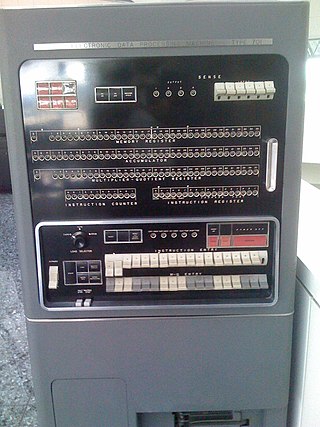701 may refer to:

Fortran is a third generation, compiled, imperative programming language that is especially suited to numeric computation and scientific computing.

A line printer prints one entire line of text before advancing to another line. Most early line printers were impact printers.

The IBM 704 is the model name of a large digital mainframe computer introduced by IBM in 1954. It was the first mass-produced computer with hardware for floating-point arithmetic. The IBM 704 Manual of operation states:
The type 704 Electronic Data-Processing Machine is a large-scale, high-speed electronic calculator controlled by an internally stored program of the single address type.

The IBM 701 Electronic Data Processing Machine, known as the Defense Calculator while in development, was IBM’s first commercial scientific computer and its first series production mainframe computer, which was announced to the public on May 21, 1952. It was designed and developed by Jerrier Haddad and Nathaniel Rochester and was based on the IAS machine at Princeton.

The IBM 700/7000 series is a series of large-scale (mainframe) computer systems that were made by IBM through the 1950s and early 1960s. The series includes several different, incompatible processor architectures. The 700s use vacuum-tube logic and were made obsolete by the introduction of the transistorized 7000s. The 7000s, in turn, were eventually replaced with System/360, which was announced in 1964. However the 360/65, the first 360 powerful enough to replace 7000s, did not become available until November 1965. Early problems with OS/360 and the high cost of converting software kept many 7000s in service for years afterward.

Total Operations Processing System (TOPS) is a computer system for managing railway locomotives and rolling stock, known for many years of use in the United Kingdom.

The IBM ThinkPad 701 is a subnotebook in the ThinkPad line by IBM. The 701 is colloquially known as the Butterfly due to its sliding keyboard, which was designed by John Karidis. It was developed from 1993 and sold from March 1995 until later that year and priced between $1,499 and $3,299. The 701 was the most sold laptop in 1995 and has received 27 design awards. It was based on either the DX2 or the DX4 version of the Intel i486, combined with CT-65545 graphics chip from Chips and Technologies. The 701Cs version used a DSTN display, while the 701C used a TFT LCD. It was pre-installed with Windows 3.11 and for the DX4 models also with OS/2 Warp 3.0. The 701 was discontinued because the keyboard design was no longer a necessity after screen sizes increased. After its discontinuation there has been some speculation about a new notebook with a butterfly style keyboard.

The IBM 1403 line printer was introduced as part of the IBM 1401 computer in 1959 and had an especially long life in the IBM product line.

In computer architecture, 36-bit integers, memory addresses, or other data units are those that are 36 bits wide. Also, 36-bit central processing unit (CPU) and arithmetic logic unit (ALU) architectures are those that are based on registers, address buses, or data buses of that size. 36-bit computers were popular in the early mainframe computer era from the 1950s through the early 1970s.

The IBM 716 line printer was used with IBM 700/7000 series computers in the 1950s and 1960s. It was introduced on May 21, 1952 with the IBM 701 and withdrawn from marketing on July 14, 1969.
9000 may refer to:
Speedcoding, Speedcode or SpeedCo was the first high-level programming language created for an IBM computer. The language was developed by John W. Backus in 1953 for the IBM 701 to support computation with floating point numbers.
305 may refer to:
PACT was a series of compilers for the IBM 701 and IBM 704 scientific computers. Their development was conducted jointly by IBM and a committee of customers starting in 1954. PACT I was developed for the 701, and PACT IA for the 704. The emphasis in that early generation of compilers was minimization of the memory footprint, because memory was a very expensive resource at the time. The word "compiler" was not in widespread use at the time, so most of the 1956 papers described it as an "(automatic) coding system", although the word compiler was also used in some papers.

The 701 series is an AC electric multiple unit (EMU) train type operated on local services by East Japan Railway Company, Aoimori Railway, and Iwate Galaxy Railway (IGR) in Japan. The design is derived from the 209 series commuter EMU, and was intended to replace locomotive-hauled trains formed of JNR 50 series coaches in the north of Japan.

The 719 series is an AC electric multiple unit (EMU) train type introduced in 1989 by East Japan Railway Company on services in the Miyagi, Yamagata, and Fukushima areas of Japan.

The IBM Naval Ordnance Research Calculator (NORC) was a one-of-a-kind first-generation computer built by IBM for the United States Navy's Bureau of Ordnance. It went into service in December 1954 and was likely the most powerful computer at the time. The Naval Ordnance Research Calculator (NORC), was built at the Watson Scientific Computing Laboratory under the direction of Wallace Eckert.
The IBM ThinkPad 500 is a subnotebook from the ThinkPad series released by IBM in 1993.
9020 may refer to: